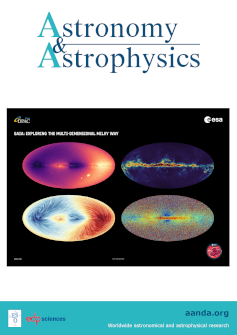在颗粒上跳舞:CO的变化及其同位素通量是表面化学和金牛座T盘性质的结果
IF 5.8
2区 物理与天体物理
Q1 ASTRONOMY & ASTROPHYSICS
引用次数: 0
摘要
上下文。原行星盘研究中最重要的问题之一是确定它们的参数,如它们的大小、年龄、恒星特征,以及最重要的,盘内气体的质量。目前,推断盘面质量的主要方法之一是结合CO同位素线观测。许多理论研究已经得出结论,CO一定是一种可靠的气体示踪剂,因为它的相对丰度只与圆盘参数有微弱的关系。然而,观测到的线通量不能很容易地用来推断柱密度,更不能推断CO.Aims的丰度。本研究的目的是研究CO同位素毫米谱线通量对金牛座T星周围标准原行星盘天体化学模型参数的依赖关系,并得出它们是否可以单独或组合使用以可靠地确定盘参数的结论。我们的案例与文献中早期的研究不同,采用了一个综合的化学网络,包括颗粒表面化学,以及线辐射转移方法。我们使用天体化学模型ANDES和辐射传输代码RADMC-3D模拟了一组具有不同关键参数(磁盘质量、磁盘半径、恒星质量和倾角)的磁盘的CO同位素线通量。我们研究了这些值是如何随着一个参数的变化和其他参数的固定而变化的,并近似了对数线性的依赖关系。我们描述了CO同位素通量对所有选择的磁盘参数的依赖性。对每个参数分析和解释导致这些依赖性的物理和化学过程。我们表明,使用13CO和C18O线通量的组合,只能在两个数量级的不确定度和一个数量级的不确定度的特征半径内估计质量。我们发现颗粒表面化学的加入降低了13CO和C18O的通量,这有助于解释以往研究中对圆盘质量的低估。本文章由计算机程序翻译,如有差异,请以英文原文为准。
Dancing on the grain: Variety of CO and its isotopologue fluxes as a result of surface chemistry and T Tauri disk properties
Context. One of the most important problems in the study of protoplanetary disks is the determination of their parameters, such as their size, age, stellar characteristics, and, most importantly, gas mass in the disk. At the moment, one of the main ways to infer the disk mass is to use a combination of CO isotopologue line observations. A number of theoretical studies have concluded that CO must be a reliable gas tracer, as its relative abundance only depends weakly on disk parameters. However, the observed line fluxes cannot always be easily used to infer the column density, much less the abundance of CO.Aims. The aim of this work is to study the dependence of the CO isotopologue millimeter line fluxes on the astrochemical model parameters of a standard protoplanetary disk around a T Tauri star and to conclude whether they can be used individually or in combinations to reliably determine the disk parameters. Our case is set apart from earlier studies in the literature by the adoption of a comprehensive chemical network with grain-surface chemistry, together with line radiative transfer.Methods. We used the astrochemical model ANDES together with the radiative transfer code RADMC-3D to simulate CO isotopologue line fluxes from a set of disks with varying key parameters (disk mass, disk radius, stellar mass, and inclination). We studied how these values change with one parameter varying and others fixed and approximated the dependences log-linearly.Results. We described the dependences of CO isotopologue fluxes on all chosen disk parameters. Physical and chemical processes responsible for these dependences are analyzed and explained for each parameter. We show that using a combination of the 13CO and C18O line fluxes, the mass can be estimated only within two orders of magnitude uncertainty and a characteristic radius with an uncertainty of one order of magnitude. We find that the inclusion of the grain-surface chemistry reduces 13CO and C18O fluxes, which can help explain the underestimation of disk mass in the previous studies.
求助全文
通过发布文献求助,成功后即可免费获取论文全文。
去求助
来源期刊

Astronomy & Astrophysics
地学天文-天文与天体物理
CiteScore
10.20
自引率
27.70%
发文量
2105
审稿时长
1-2 weeks
期刊介绍:
Astronomy & Astrophysics is an international Journal that publishes papers on all aspects of astronomy and astrophysics (theoretical, observational, and instrumental) independently of the techniques used to obtain the results.
 求助内容:
求助内容: 应助结果提醒方式:
应助结果提醒方式:


